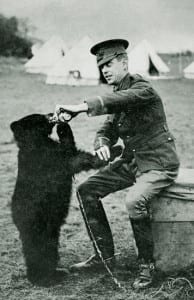Read: Finding Winnie, illustrated by Sophie Blackall and written by Lindsay Mattick.
 In 1914, Harry Colebourn, a veterinarian on his way to tend horses in World War I, followed his heart and rescued a baby bear. He named her Winnie, after his hometown of Winnipeg, and he took the bear to war.
In 1914, Harry Colebourn, a veterinarian on his way to tend horses in World War I, followed his heart and rescued a baby bear. He named her Winnie, after his hometown of Winnipeg, and he took the bear to war.
Harry Colebourn’s real-life great-granddaughter tells the true story of a remarkable friendship and an even more remarkable journey–from the fields of Canada to a convoy across the ocean to an army base in England…
And finally to the London Zoo, where Winnie made another new friend: a real boy named Christopher Robin.

Second grade students will learn how primary sources tell a story. Photo Analysis PDF
Primary sources are not just documents and written records. There are many different kinds of primary sources, including: first-person accounts, documents, physical artifacts, photographs and scientific data that has been collected but not interpreted, and face-to-face mentors with specific knowledge or expertise. The important thing to remember is they were used or created by someone with firsthand experience of an event.
How do the primary source photographs help tell the story of Winnie the Pooh? Look here to learn more about the true story of Winnie the Pooh and Harry Coleman, the man who bought a bear!
